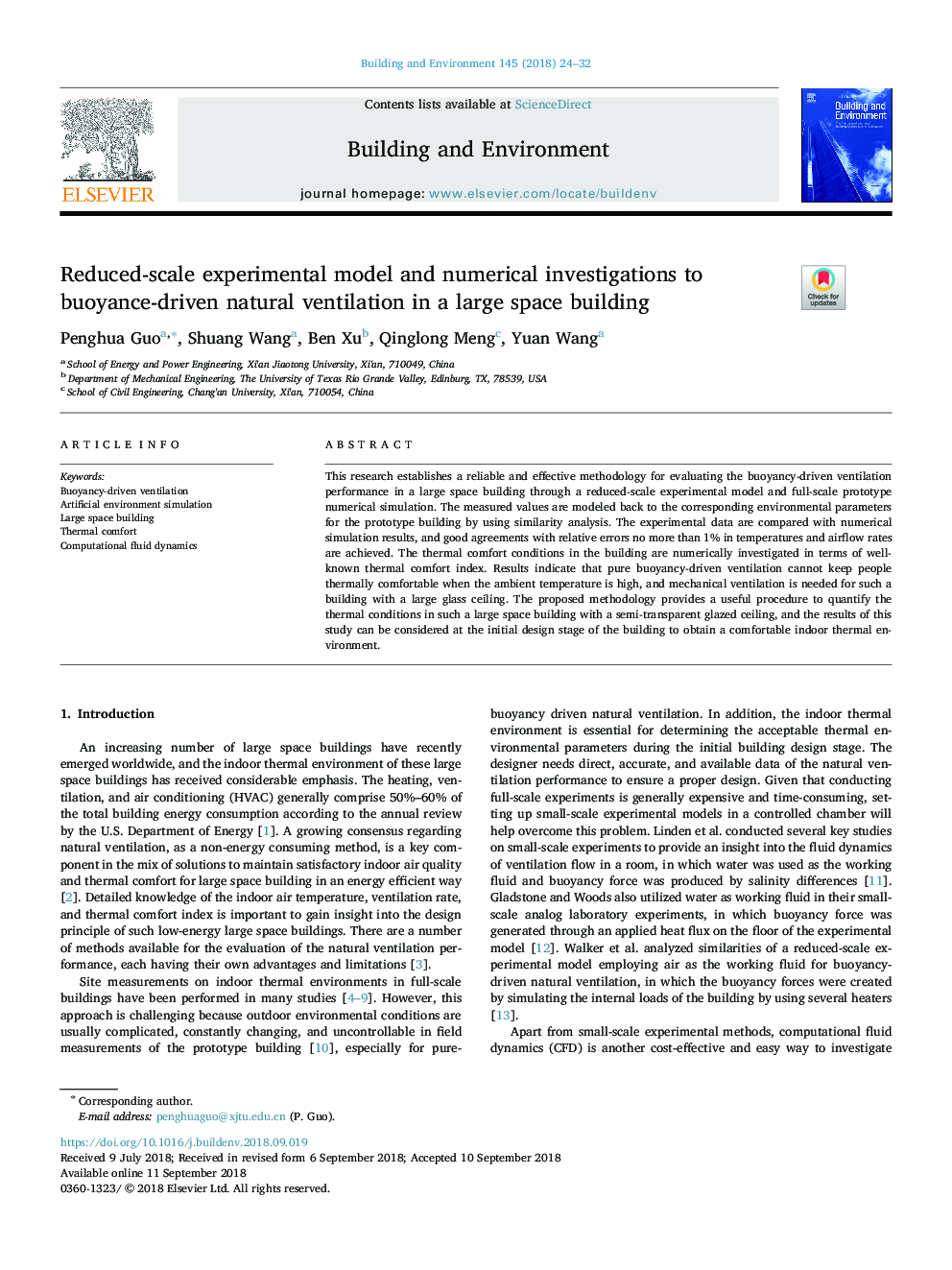| کد مقاله | کد نشریه | سال انتشار | مقاله انگلیسی | نسخه تمام متن |
|---|---|---|---|---|
| 10150680 | 1663924 | 2018 | 9 صفحه PDF | دانلود رایگان |
عنوان انگلیسی مقاله ISI
Reduced-scale experimental model and numerical investigations to buoyance-driven natural ventilation in a large space building
ترجمه فارسی عنوان
مدل آزمایشی در مقیاس کوچک و تحقیقات عددی برای تهویه طبیعی بوئینگ در یک ساختمان فضایی بزرگ
دانلود مقاله + سفارش ترجمه
دانلود مقاله ISI انگلیسی
رایگان برای ایرانیان
کلمات کلیدی
تهویه هوا شناور، شبیه سازی محیط مصنوعی، ساخت فضای بزرگ، راحتی حرارتی، دینامیک سیالات محاسباتی،
ترجمه چکیده
این تحقیق یک روش قابل اعتماد و موثر برای ارزیابی عملکرد تهویه هوا شناور در یک ساختمان فضایی بزرگ را از طریق یک مدل آزمایشی در مقیاس کوچک و شبیه سازی عددی نمونه اولیه کامل ارائه می دهد. با استفاده از تجزیه و تحلیل شباهت، مقادیر اندازه گیری شده به پارامترهای محیطی مربوط به ساختمان نمونه اولیه مدل سازی می شوند. داده های آزمایشی با نتایج شبیه سازی عددی مقایسه می شود و قراردادهای خوب با خطاهای نسبی در بیش از 1٪ در دمای و نرخ جریان هوا به دست نمی آیند. شرایط راحتی حرارتی در ساختمان به صورت عددی از نظر شاخص راحتی درجه حرارت شناخته شده است. نتایج حاکی از آن است که تهویه هواپیما بر پایه خنک کننده نمیتواند مردم را در شرایط حرارت بالا با دمای بالا بالا ببرد و تهویه مکانیکی برای چنین ساختمان با سقف شیشه ای بزرگ مورد نیاز است. روش پیشنهادی روش مفیدی برای اندازه گیری شرایط حرارتی در چنین ساختمان فضایی با سقف شیشه ای نیمه شفاف فراهم می کند و نتایج این مطالعه می تواند در مرحله طراحی اولیه ساختمان برای دستیابی به محیط گرم محیطی داخلی .
موضوعات مرتبط
مهندسی و علوم پایه
مهندسی انرژی
انرژی های تجدید پذیر، توسعه پایدار و محیط زیست
چکیده انگلیسی
This research establishes a reliable and effective methodology for evaluating the buoyancy-driven ventilation performance in a large space building through a reduced-scale experimental model and full-scale prototype numerical simulation. The measured values are modeled back to the corresponding environmental parameters for the prototype building by using similarity analysis. The experimental data are compared with numerical simulation results, and good agreements with relative errors no more than 1% in temperatures and airflow rates are achieved. The thermal comfort conditions in the building are numerically investigated in terms of well-known thermal comfort index. Results indicate that pure buoyancy-driven ventilation cannot keep people thermally comfortable when the ambient temperature is high, and mechanical ventilation is needed for such a building with a large glass ceiling. The proposed methodology provides a useful procedure to quantify the thermal conditions in such a large space building with a semi-transparent glazed ceiling, and the results of this study can be considered at the initial design stage of the building to obtain a comfortable indoor thermal environment.
ناشر
Database: Elsevier - ScienceDirect (ساینس دایرکت)
Journal: Building and Environment - Volume 145, November 2018, Pages 24-32
Journal: Building and Environment - Volume 145, November 2018, Pages 24-32
نویسندگان
Penghua Guo, Shuang Wang, Ben Xu, Qinglong Meng, Yuan Wang,
